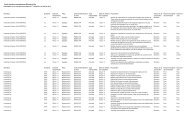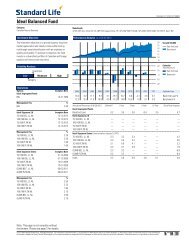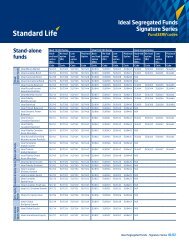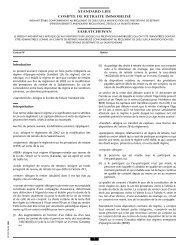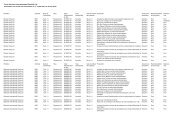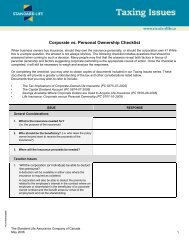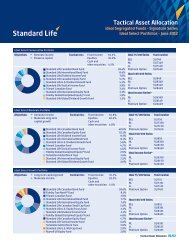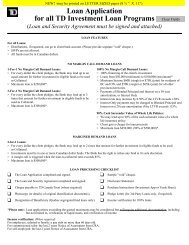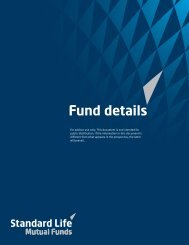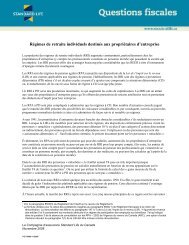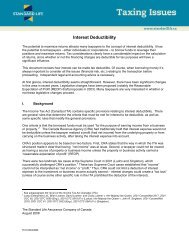Leveraged Supplementary Retirement Account - Standard Life
Leveraged Supplementary Retirement Account - Standard Life
Leveraged Supplementary Retirement Account - Standard Life
You also want an ePaper? Increase the reach of your titles
YUMPU automatically turns print PDFs into web optimized ePapers that Google loves.
<strong>Leveraged</strong> <strong>Supplementary</strong> <strong>Retirement</strong> <strong>Account</strong><br />
Deductibility for tax purposes<br />
General Anti-Avoidance Rule (GAAR)<br />
Conclusion<br />
In cases where a business leverages the life<br />
insurance policy, one must look at the facts on<br />
a case-by-case basis to determine if interest will<br />
be deductible.<br />
On October 31, 2003, the Department of<br />
Finance introduced proposals relating to<br />
interest deductibility. If a deduction is to be<br />
sought for the interest paid on any borrowings,<br />
the borrower should consult their tax advisor<br />
as to the impact of these proposed rules. For<br />
additional information on this topic, please refer<br />
to the Taxing Issues document entitled, “Interest<br />
Deductibility” (PC 6141).<br />
Deductibility for tax purposes of life<br />
insurance annual premiums<br />
A policyholder may be able to deduct all or a<br />
portion of the life insurance premiums where<br />
the policy is used as collateral, provided that<br />
the policy is assigned to a restricted financial<br />
institution, the interest incurred on the loan<br />
is deductible, and the restricted financial<br />
institution requires the policy as collateral.<br />
The amount deductible is to be capped at the<br />
lesser of the premiums payable in respect of<br />
the year, and the Net Cost of Pure Insurance<br />
(NCPI) for that year. It will also need to be related<br />
to the amount owed versus the life insurance<br />
coverage amount.<br />
For additional information on this topic, please<br />
refer to the Taxing Issues document entitled,<br />
“Leveraging <strong>Life</strong> Insurance Policies” (PC 6244).<br />
General Anti-Avoidance Rule<br />
(GAAR)<br />
Subsection 245(2) of the ITA contains a provision<br />
called the General Anti-Avoidance Rule (GAAR).<br />
The provision allows CRA to recharacterize a<br />
transaction if the transaction is a misuse or<br />
abuse of the provisions of the Act. If CRA applied<br />
GAAR to leveraged insurance transactions, it<br />
might attempt to recharacterize the loan from<br />
the financial institution as a policy loan. If it is<br />
deemed to be a policy loan, amounts in excess<br />
of the policy’s adjusted cost basis would be<br />
taxable. It is arguable that GAAR should not<br />
apply to recharacterize the loan. One argument<br />
is that a policy loan is defined in the Act to be an<br />
amount advanced by an insurer in accordance<br />
with the terms of the policy. Since the insurer is<br />
not advancing the funds in accordance with the<br />
terms of the policy, the transaction should not fit<br />
within the definition of policy loan.<br />
Conclusion<br />
As with any investment option, it is important to<br />
review both the risks and rewards. In the right<br />
situation, an LSRA can provide additional cash<br />
flow in retirement and provide permanent life<br />
insurance for the individual’s beneficiaries.<br />
<strong>Standard</strong> <strong>Life</strong> 11




